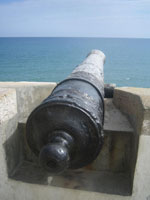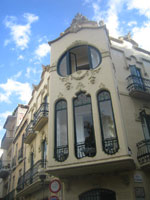Sitges Guide
1 Travel tips
We update this page regularly with useful tips and travel advice for visitors to Sitges, and you should find some handy hints on what to expect…
Read more »2 Getting to Sitges
Above: Scoot along to Sitges Below: Easy does itBy air Sitges doesn't have it's own air traffic node, but is nearly as close (approx.…
Read more »3 Getting around Sitges
Above: Mod-ernism in Sitges Below: Are you taking the Mickey?The core of Sitges takes just 10 to 15 minutes to traverse by foot, so safe to…
Read more »4 Money Matters
All major hotels, restaurants, bars and shops will accept all the major credit cards, however you may be asked to produce photo ID to confirm your…
Read more »5 Language
Fear not Spanish-speakers, your evening classes in Castellano won't go to waste in Sitges, where Spanish is the most widely spoken language in town.…
Read more »6 Info about Sitges & Spain
Full information, facts, figures and stats on Sitges in Catalonia Spain coming soon, along with neighbours Vilanova and Castelldefels on the Costa…
Read more »About the guide
 Above: Some come for the big guns
Below: Sitges' more surreal architecture
Above: Some come for the big guns
Below: Sitges' more surreal architecture
Orientating yourself in Sitges is far from difficult, and whilst there's plenty of things to see and do to keep you occupied for a day trip, long weekend, or even a lifetime (if you love sand and sea), this is a town best wondered around aimlessly - rather than with a map in hand, ticking off tourist attractions. This former fishing village has retained a casual laidback air, far removed from the chaos of Barcelona up the road, and even if you do little more in Sitges than stroll around the picturesque streets and collapse on one of its 17 beaches you'll feel your time was well spent.
If you arrive in Sitges by rail then you'll find the tourist information office on the left as you exit the train station, and here is obviously a good place to pick up a map and get some tips and advice. Otherwise charge up your iPhone and consult our online map to keep track of your whereabouts. The main cultural sights consist of Sant Bartomeu church and the Cau Ferrat and Maricel museums. All are concentrated on a small headland which was once the heart of the medieval Old Town. The church you might recognise from any number of postcards, and is worth a visit for its Gothic tombs and Renaissance altarpiece, whilst Cau Ferrat is famous for its association with the artist and playwright Santiago Rusinol.
A key proponent of the Art Nouveau movement taking place in Catalonia at the time, Rusinol fell in love with Sitges thanks to the beauty of the natural landscape and Mediterranean sea and the quality of the natural light, and it was he who was largely responsible for fostering an increase of artistic and intellectual activity in the town in the late 19th/early 20th century. He bought the Cau Ferrat house (currently closed for refurbishment) to exhibit his enormous collections of iron work, sculptures, glass pieces, sketches and paintings and this intriguing collection remains the best museum in the city. (There are only three to be fair!).
With the culture safely out of the way you're fee to explore, not so much the specific points in Sitges, but its broader charms. The streets are full of eye-catching buildings and architectural features, much of it flavoured by the Art Nouveau movement championed by Rusinol and chums. Brightly-tiled balconies, beautiful ceramic street signs and grand facades appear on every corner, whilst Mother Nature chips in too with palm trees, Bourgainvillea and assorted flowers (which the residents love to display from open shutters). By day these streets bustle with casual shoppers browsing fashion boutiques, art galleries and curio shops, by night everyone returns in their glam rags for long dinners followed by even longer nights out... Sitges has one of the most lively nightlife in Spain, thanks in the main as its reputation as a gay holiday destination.
Of course, being a coastal resort, Sitges' main attractions are its beaches - 17 of them if you count generously! The majority appear, separated by breakers, in a long strip from the Church down to the Terramar Hotel, although other, more secluded bays, pop up on the east side of the Old Town, such as the central San Sebastian and - a little further - the nudist beach of Balmains much loved by gay tourists. Whether you're a beach bum or not the coast is a wonderful place to take a stroll and enjoy that fine light that so inspired Rusinol. You'll find no shortage of rollerbladers, skateboarders, joggers and walkers taking in a sea breeze on the seemingly endless Passeig Maritim.
Sitges is far from a jewel in isolation and all up and down the Costa Brava coast you'll find a glut of other great destinations to visit, starting with neighbours Vilanova (to the South-West) and Castelldefels (to the North-East), but also including Tarragona, Calafel, and Vic. Naturally, if you're spending any length of time in Sitges, it would be bordering on criminal not to visit the Catalan capital... in which case our amigos at Barcelona Life are just a mouse click away with all the advice you need!
